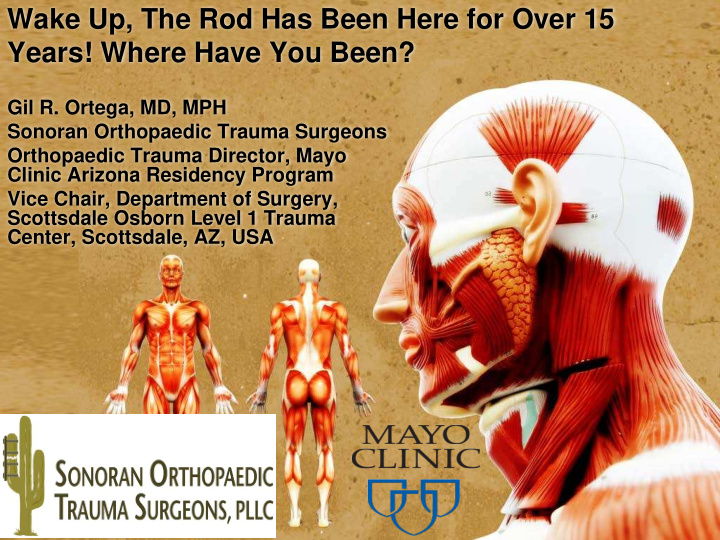



Wake Up, The Rod Has Been Here for Over 15 Years! Where Have You Been? Gil R. Ortega, MD, MPH Sonoran Orthopaedic Trauma Surgeons Orthopaedic Trauma Director, Mayo Clinic Arizona Residency Program Vice Chair, Department of Surgery, Scottsdale Osborn Level 1 Trauma Center, Scottsdale, AZ, USA
Disclosures • Founding Member, Orthopaedic Board of Advisors: Carbofix • Founding Member, Orthopaedic Board of Advisors: Artross Nanobone • Consultant: Smith and Nephew
Remember This One Slide and do the right thing for your patients…Nail Their IT fracture • Less blood loss with Nail • Less OR time with Nail • Less Fluoro time with Nail • Better gait patterns postop with Nail (lower mobility scores with plate) • More total hip conversions with plate • Less Frustration taking resident through Nail than Plate (Ok maybe this isn’t published, but you know its true)
Treatment Facts • Reduction, Reduction, Reduction – Restores mechanics – Reduce stress on surgical implant – Leads to shorter healing time and complete fracture healing – Need to restore normal neck-shaft angle – Restore normal rotational femoral alignment and length – Eliminate translation
TAD • Key is reduction and central positioning of lag screw in femoral head • Tip-apex distance: Baumgaertner et al.
Nailing vs. Plating
Is there evidence for shift for more Nails than Plates? • Anglen et al. Nail or Plate Fixation of Intertrochanteric Hip Fractures: Changing Pattern of Practice • Nail fixation rate increasing from 3% in 1999 to 67% in 2006 • Change has occurred despite lack of evidence in literature supporting change and in face of more potential complications with Nails Jeffrey O. Anglen, James N. Weinstein; Nail or Plate Fixation of Intertrochanteric Hip Fractures: Changing Pattern of PracticeA Review of the American Board of Orthopaedic Surgery Database. The Journal of Bone & Joint Surgery. 2008 Apr;90(4):700-707.
IM Fixation vs. SHS Randomized/prospective trial of 210 pts. Results – Fewer blood transfusions needed with IM – Better walking ability (unstable fxs) with IM – No shaft fxs & Fewer re-ops with IM Conclusion • IM fixation or SHS for stable fxs • IM fixation for Unstable fxs • Utrilla, et al. JOT 4/05
SHS: Mechanical “Achilles' Heal” • Iatrogenic, intraoperative lateral wall fracture 31% risk in A2. 2&3 fxs 22% failure rate (vs. 3%) A2 to A3 fx! ? Palm, et al JBJS(A) ‘07
Lateral Wall Fracture and IMN? • Determine incidence of intraoperative lateral wall fracture in OTA 31.A1 and A2 fractures • 165 patients (31.A1/A2-231, A3-60) completed followup – Group 1 (129 patients, 78%) consisted of patients with intact lateral wall postoperatively – Group 2 (36 patients, 22%) consisted of patients who sustained lateral wall fracture intraoperatively – Incidence of intraoperative lateral wall fracture was 21% – Fracture collapse and failure rate were not statistically significant in either groups (group 1: 1%, group 2: 5%) – Presence of lateral wall fracture did not adversely affect healing of pertrochanteric fractures Boopalan Et al. J Orthop Trauma. 2012 Apr 5.
Reverse Oblique Fractures 49 fx/10 yrs @ Mayo 56% failure with SHS 20%with DCS Haidukewych, JBJS(A) 01
Nails vs Plates • Systematic review of outcomes of extramedullary and intramedullary fixation • Three Level I and 9 Level IV studies reviewed – Grade B (fair) evidence shows • Operative time reduced with IM fixation • Fixation failure reduced with IM fixation Kuzyk et al. Intramedullary vs. extramedullary fixation for subtrochanteric fractures. (J Orthop Trauma 2009;23:465–470)
Remember This One Slide and do the right thing for your patients…Nail Their IT fracture • Less blood loss with Nail • Less OR time with Nail • Less Fluoro time with Nail • Better gait patterns postop with Nail (lower mobility scores with plate) • More total hip conversions with plate • Less Frustration taking resident through Nail than Plate (Ok maybe this isn’t published, but you know its true)
Thank You
Recommend
More recommend